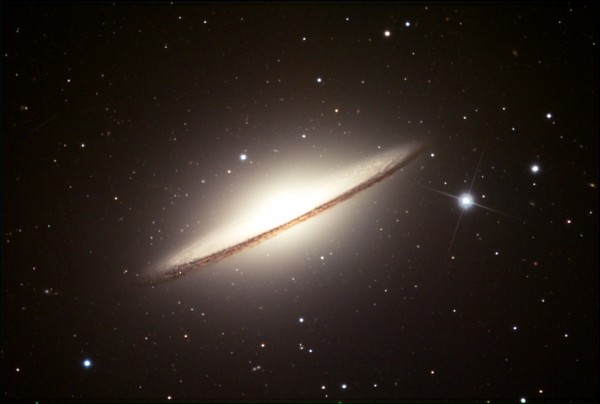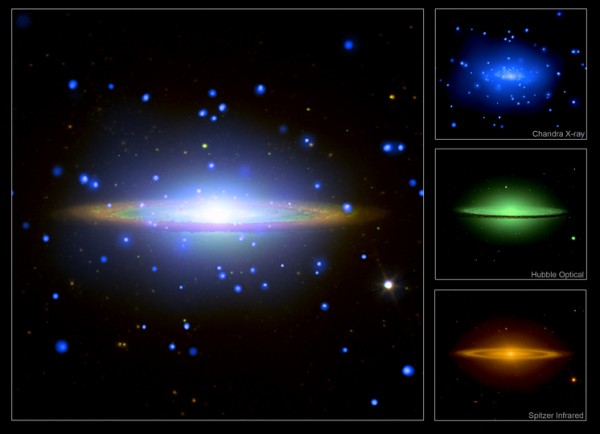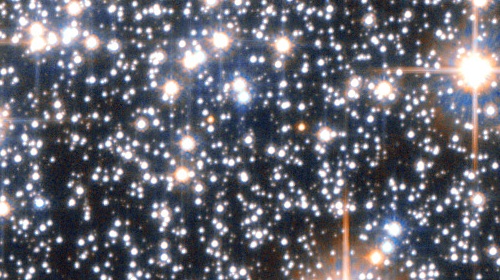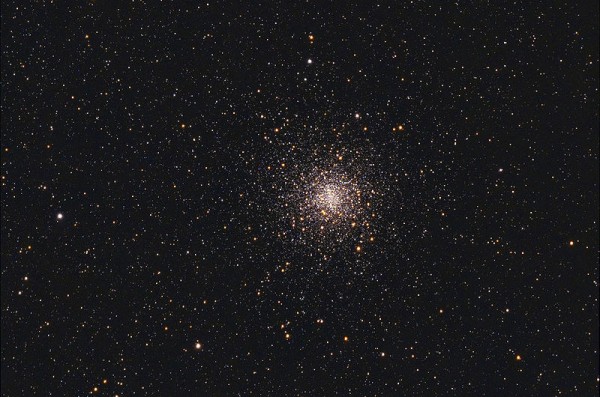"I may be an old lion, but if someone puts his hand in my mouth, I can still bite it off." -Wilhelm Steinitz
When you look at a typical galaxy, you usually find a disk, a bulge, and a few dots diffusely strewn about the exterior.

Like an old lion, these dots have been around for a very long time: often for longer than the galactic disk itself! Just what are these things? Well, we can learn a little more if we look in the X-ray (with Chandra) and the infrared (with Spitzer), in addition to a visible light image (from Hubble). Let's take a look at a composite:

Just what are these dots that are bright in X-rays and visible light, but dim in the infrared? Say hello to Globular Clusters. A typical galaxy, like our Milky Way, has a couple of hundred globular clusters in it. Just what is a globular cluster? Let's go in for a closer inspection.

This is globular cluster M72, as taken by Hubble back in 1999. M72 is a pretty typical globular cluster; average size, brightness, etc. (Perhaps it's even a little bit younger than most.) But what does that mean? Let's recall what's going on in our own neighborhood.

Each ring on this diagram is about 13 light-years in radius. By contrast, the globular cluster M72 is about 21 light years in radius.
Total.
In other words, if we drew a sphere around the Sun of the same radius as M72, we'd get under 100 stars. How many stars do you suspect are in a globular cluster like M72?

About a million. Don't believe me from that image above? Click on it. And what you'll see is that there really are about a million stars in there! In fact, here's a little snippet of the middle of this image.

This "snippet" is less than 1% the size of the image above it! Yes, there are really over a million stars in this globular cluster. And while there used to be tens of thousands of them around our galaxy, there are only about 200 left, destroyed by gravity and repeated collisions with our galactic disk.
But that's not the mystery. There are two, and I'll have the resolutions for you next week, but I want to give you the weekend to think about it.

Mystery #1: There's nothing smaller! Yes, we have dwarf galaxies with only a few tens of millions of stars in them, but a small globular cluster may only have a few hundred thousand stars (like M4, our closest globular cluster, above). But while we can make things bigger and bigger, there's nothing in the Universe that's a smaller structure (containing stars) than a globular cluster! Why couldn't there be collections of a few, or a few hundred, or a few thousand stars just on their own in this Universe? A few hundred thousand stars seems to be the magic number, and we've discovered many thousands of globular clusters with these properties.

Mystery #2: Why aren't they ever found on their own? People have looked, and globular clusters only exist bound to other, larger structures; they're never on their own!
Interesting, isn't it? These super-dense balls with hundreds of thousands (or even millions) of stars in them, orbiting around galaxies everywhere, but never smaller than a few hundred thousand stars and never on their own. Weird! So think about it, tell me your guesses, and I'll be back with the answer next week!

Globular cluster images appear to have filamentary structure. Has anyone considered this as evidence for dark matter?
It has always intrigued me that zero is anathemic for quantum physics. Is zero a mathematically viable "quantity " for quantum phenomena?
It's obvious, really! Just globular clusters are artificial homes of superintelligent civilizations :)
Though, seriously, I'd bet on that small clusters don't have deep enough gravity wells to trap stars. And large clusters more than million stars probably have wells deep enough to disrupt the host galaxy into a boring elliptical galaxy.
Why no standalone clusters? Easy. There's no way they can form: no stars, no stellar wind, no supernovaue - no way to compress intergalactic gas enough to form stars.
1.) Hypothesis: the smaller the number of stars the smaller the combined gravity well (i.e. the combined effect of their gravity across a large volume). The larger the combined gravity well the greater likelihood that a star gravitationally expelled from the 'inner cluster' will eventually rejoin the cluster. The smaller the combined gravity well the greater the likelihood that a star gravitationally expelled from the 'inner cluster' will 'just keep on going. [prediction: there are smaller, and even smaller, cluster - but they are increasingly _rare_.]
2a.) Hypothesis: Dude, they _used to be_ on their own, or at least some of them were, but over time more and more of them have become noticeably gravitationally bound to the nearest actual galaxy. [prediction: there are smaller, and even smaller, clusters unassociated with galaxies - but the evidence is very very far away and hard to see.]
2b.) Hypothesis: The smaller the cloud of interstellar gas the less able it is to for stars - the aggregate gravity of the cloud produces a gradient which enables locally greater concentrations of gas/dust until there is sufficient compression to form a star. The smaller aggregate gravity well of a smaller cloud is less able to form stars, thus star clusters that are far away from a gravitational gradient (i.e. a galaxy) are unlikely to occur, and smaller clusters are less likely to occur. [prediction: smaller clusters are very _rare_, all across the discernible sky.]
Last I heard, which was some time ago, there was a third mystery: why don't they collapse into a black hole? Was that solved?
A number of intergalactic globular clusters are known, not attached to any galaxies.
At the risk of sounding ignorant -- I don't understand the diagram with the rings. The explanation states that "each ring has a radius of 13 light years." How do rings that are different distances from the center have the same radius? What am I missing?
Rachael, I think he means that each ring is 13 light years (funny number - 4 parsecs?) bigger than the next smaller one.
It's known any given globular cluster is of a single age; generally they're metal poor, so these are stars that have been formed directly from a body of gas, without supernovae and other things to put metals in.
No infrared emissions means no dust in GC's, which supports a rough hypothesis that they were a single mass of gas that was forced to collapse into stars.
Hypothesis: GC's are the remnants of large gas clouds bound to lumps of dark matter in a galactic halo. When such a lump drags the associated gas into another piece of gas (or the outer disk), you get strong compression of the gas and star formation.
If the lump of dark matter is small, the gas becomes unbound from the dark matter and stays in the disk as a open cluster, and eventually will disperse.
If the lump of dark matter is bigger, the gas remains bound, and you end up with a large mass of collapsing gas orbiting the dark matter. Friction trades KE for temperature which radiates away, so the collapsing gas will eventually settle down to being close to the core of the dark matter lump. Lots of stars form at the same time, and all directly from virgin gas, so are low in metals. These would be far harder to disrupt because they're essentially bound to the mass of dark matter, and so interactions with the disk matter far less.
Pleiades is a star cluster having only ~1000 stars, so globular clusters are not the smallest. You lie, Ethan! ;-)
More like 20 Light year intervals.
Mu Ara on the bottom right is 49.8 LY from Sol and 11.5° South. On the map it's about 2.4 intervals away from Sol.
On further reflection, in this 3D portrayal the chart has been stretched considerably in the vertical plane, so the dropped perpendiculars would not be true.
13 Light years it is.
If these figures are correct, then if the Sun were located in this globular cluster, there would be over 100 stars within a radius of one light-year. Why do I get the impression that science fiction there wouldn't have too many stories about faster-than-light travel or cranks denouncing the local equivalent of Einstein?
Star clusters are born from big clouds of hydrogen and produce stars of various size, more of the smaller, few of the bigger. A small star cluster will not have any massive B or O stars, but will have so weak gravity that galactic tides will eventually disrupt it.
A bigger cluster of gas and forming stars will produce one or several really massive stars that shine so strongly that the radiation pressure will scatter the cloud of gas and disrupt the star forming process.
An even bigger cluster of gas and stars will have enough gravity to oppose the repelling force of radiation pressure from the O/B stars. The star-forming process will be effective, and the result will be a big globular star cluster. The gravity will also be strong enough to allow the cluster to survive galactic tidal forces for a long time.
The picture above gets a bit complicated when factoring in dark matter. If a globular cluster is massive enough to retain dark matter, the added mass would make it very reistent to tidal disruption, but I do not know enough about the current state of dark-matter knowledge to speculate about the fraction of dark matter versus visible matter.
Why don't GCs rotate? Why don't the stars within collapse into each other via gravity?
Since some Globular Clusters are situated in the halo and are effected by Galaxy core accretion, I would speculate that the precursor gas is a primordial density remnant from galaxy creation or disturbance, and the accretion and sequential firing up of the gas is due to many factors, namely it's proximity to galactic core versus mass density of gas sphere producing a galactic eddy.
Given that the GC's are not found as mavericks, maybe suggest that wandering, clumping, spherical dense primordial gases could be a product of using the dwarf galaxies as the play toy of competing galaxies stripping material from them until one of them wins and fires up the gas in a jubilant triumphant brilliance.
ya know, kinda like...I won, In your face Andromeda!
@Aaron, Ethan was referring to the smallest structures within the Universe..not within our own galaxy. Pleiades is an open star cluster, not a globular cluster. Globular clusters are predominantly located beyond the spiral arms and around the milky way's halo.
12 1nd 14 seem to be pretty good attempts at expaination. Most likely the dynamics of star clusters changes after a certain size. Either as birger speculates at being massive enough to retain gas against the stellar winds from the O&B starts, or perhaps they are large enough to attract (or was the DM that did the attracting) dark matter. In any case, it is clear that the gas didn't stick around too long, GCs starts seem to have been formed in a short period of time, then the gas was lost -possibly due to supernovas of the original compliment of O&B starts.
I suspect it takes a pretty dense agglomeration of gas to form one of these. Outside of the immediate environs of a forming galaxy there probably just wasn't enough gas to form one.
Easier to answer, Why do they look the way they do? I played weekend armchair astrophysicist a couple of years back, running sims of clusters of a few hundred stars. They all evolve to look like GCs. I think any initial angular momentum gets bleed off, as higher velocity stars preferentially "evaporate" from the cluster. Perhaps we need some captured dark matter to slow the rate of star loss from GCs to have them survive 10+ bilion years? Are there any good estimates of their masses versus the sum of the mases of their constituent starts?
1. Globular clusters must have started with enough mass to allow the gas cloud to collapse under its own self-gravity, there being no supernovae to precipitate the collapse with shock fronts. Remember that the gas in the cloud has some finite temperature and/or angular momentum which prevents collapse if it doesn't have enough self-gravity, so any smaller agglomeration of mass never forms stars in the first place. If the gas retention limit that Birger mentioned above is stricter than the initial self-gravity limit (this possibility seems more likely), any agglomeration of gas that satisfied the gas retention limit would have become a galaxy rather than a globular cluster, since the O/B stars rapidly (compared to dynamical time scales within the mass) go supernova, producing the metals we see in later forming star systems.
2. Steinn points out that there are intergalactic globular clusters. I have no idea how common this is, since there are observational biases in play: where do you look?
Looks to me that globular clusters are the remnants of the earliest, smaller galaxies that through collisions with other early (and small) galaxies have lost most of their gravitationally weakly bound stars at the edges to form the larger spirals such as our milky way. These early galaxies are just the skeletal remains which we now see as globules which have settled into a stable orbit.